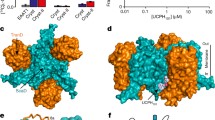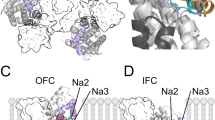Abstract
A detailed kinetic study of the inhibitory effects ofl- andd-enantiomers of cysteate, cysteine sulphinate, homocysteine sulphinate, homocysteate, and S-sulpho-cysteine on the neuronal, astroglial and synaptosomal high-affinity glutamate transport system was undertaken.d-[3H] Aspartate was used as the transport substrate. Kinetic characterisation of uptake in the absence of sulphur compounds confirmed the high-affinity nature of the transport systems, the Michaelis constant (K m) ford-aspartate uptake being 6 μM, 21 μM and 84 μM, respectively, in rat brain cortical synaptosomes and primary cultures of mouse cerebellar granule cells and cortical astrocytes. In those cases where significant effects could be demonstrated, the nature of the inhibition was competitive irrespective of the neuronal versus glial systems. The rank order of inhibition was essentially similar in synaptosomes, neurons and astrocytes. Potent inhibition (K i∼K m) of transport in each system was exhibited byl-cysteate, andl- andd-cysteine sulphinate whereas substantially weaker inhibitory effects (K i>10–1000 times the appropriateK m value) were exhibited by the remaining sulphur amino acids. In general, inhibition: (i) was markedly stereospecific in favor of thel-enantiomers (except for cysteine sulphinate) and (ii) was found to decrease with increasing chain length. Computer-assisted molecular modelling studies, in which volume contour maps of the sulphur compounds were superimposed on those ofd-aspartate andl-glutamate, demonstrated an order of inhibitory potency which was, qualitatively, in agreement with that obtained quantitatively by in vitro kinetic studies.
Similar content being viewed by others
References
Balcar, V. J., and Johnston, G. A. R. 1972. Glutamate uptake by brain slices and its relation to depolarization of neurons by acidic amino acids. J. Neurobiol. 3:295–301.
Balcar, V. J., and Johnston, G. A. R. 1972. The structural specificity of the high affinity uptake ofl-glutamate andl-aspartate by rat brain slices. J. Neurochem. 19:2657–2666.
Fagg, G. E., and Lane, J. D. 1978. the uptake and release of putative amino acid transmitters. Neuroscience 4:1015–1036.
Schousboe, A. 1981. Transport and metabolism of glutamate and GABA in neurons and glial cells. Int. Rev. Neurobiol. 22:1–45.
Schousboe, A., Larsson, O. M., Krogsgaard-Larsen, P., Drejer, J., and Hertz, L. 1988. Uptake and release processes for neurotransmitter amino acids in astrocytes. Pages 381–394,in Norenberg, M. D., Hertz, L., and Schousboe, A. (eds.) The Biochemical Pathology of Astrocytes. Alan R. Liss, Inc., New York.
Shank, R. P., and Aprison, M. H. 1988. Glutamate as a neurotransmitter. Pages 3–19,in Kvamme, E. (ed.), Glutamine and glutamate in mammals, Vol. 2. CRC Press, Boca Raton, Florida.
Logan, W. J., and Snyder, S. H. 1972. High affinity systems for glycine, glutamic acid and aspartic acid in synaptosomes of rat central nervous tissues. Brain Res. 42:413–431.
Waniewski, R. A., and Martin, D. L. 1983. Selective inhibition of glial versus neuronal uptake ofl-glutamate by SITS. Brain Res. 268:390–394.
Fonnum, F. 1984 Glutamate: A neurotransmitter in mammalian brain. J. Neurochem. 42:1–11.
Balcar, V. J., Schousboe, A., Spoerri, P. E., and Wolff, J. R. 1987. Differences between substrate specificities ofl-glutamate uptake by neurons and glia, studied in cell lines and primary cultures. Neurochem. Int. 10:213–217.
Drejer, J., Larsson, O. M., and Schousboe, A. 1983. Characterization of uptake and release processes ford- andl-aspartate in primary cultures of astrocytes and cerebellar granule cells. Neurochem. Res. 8:231–243.
Curtis, D. R., and Watkins, J. C. 1960. The excitation and depression of spinal neurons by structurally related amino acids. J. Neurochem. 6:117–141.
Curtis, D. R., and Watkins, J. C. 1963. Acidic amino acids with strong excitatory actions on mammalian neurons. J. Physiol. (Lond.) 166:1–14.
Mewett, K. N., Oakes, D. J., Olverman, H. J., Smith, D. A. S., and Watkins, J. C. 1983. Pharmacology of the excitatory actions of sulphonic and sulphinic amino acids. Pages 163–174,in Mandel, P., and de Feudis, F. V. (eds.), CNS Receptors — From Molecular Pharmacology to Behavior. Raven Press, New York.
Do, K. Q., Herrling, P. L., Streit, P., Turski, W. A., and Cuenod, M. 1986. In vitro release and electrophysiological effects in situ of homocysteic acid, an endogenous N-methyl-(d)-aspartic acid agonist, in the mammalian striatum. J. Neurosci. 6:2226–2234.
Roberts, P. J. 1974. Glutamate receptors in the rat central nervous system. Nature 252:399–401.
Recasens, M., Varga, V., Nanopoulos, D., Saadoun, F., Vincendon, G., and Benavides, J. 1982. Evidence for cysteine sulphinate as a neurotransmitter. Brain Res. 239:153–173.
Grieve, A., Dunlop, J., and Griffiths, R. 1988. Inhibition of high affinity synaptosomal uptake of D-aspartate in rat brain byl- andd-enantiomers of excitatory sulphur-containing amino acids. Biochem. Soc. Trans. 16(3):302–303.
Kilpatrick, I. C., and Mozley, L. S. 1986. An initial analysis of the regional distribution of excitatory sulphur-containing amino acids in the rat brain. Neurosci. Lett. 72:189–193.
Davies, J., Evans, R. H., Jones, A. W., Smith, D. A., and Watkins, J. C. 1982. Differential activation and blockade of excitatory amino acid receptors in the mammalian and amphibian central nervous system. Comp. Biochem. Physiol. 72:211–224.
Pullan, L. M., Olney, J. W., Price, M. T., Compton, R. P., Hood, W. F., Michel, J., and Monahan, J. B. 1987. Excitatory amino acid receptor potency and subclass specificity of sulphur-containing amino acids. J. Neurochem. 49:1301–1307.
Murphy, D. E., and Williams, M. 1987. Interaction of sulfurcontaining amino acids with quisqualate and kainate excitatory amino acid receptors in rat brain. Pages 63–66,in Hicks, T. P., Lodge, D., and McLennan, H. (eds.) Excitatory Amino Acid Transmission. Alan R. Liss, Inc., New York.
Do, K. Q., Mattenberger, M., Streit, P., and Cuenod, M. 1986. In vitro release of endogenous excitatory sulphur-containing amino acids from various rat brain regions. J. Neurochem. 46:779–786.
Hertz, L., Juurlink, B. H. J., Fosmark, H., and Schousboe, A. 1982. Astrocytes in primary culture. Pages 175–186,in Pfeiffer, S. E. (ed.), Neuroscience Approached Through Cell Culture, Vol. I. CRC Press, Boca Raton, Florida.
Messer, A. 1977. The maintenance and identification of mouse cerebellar granule cells in monolayer cultures. Brain Res. 130:1–12.
Yu, A. C. H., and Hertz, L. 1982. Uptake of glutamate, GABA, and glutamine into a predominantly GABA-ergic and a predominantly glutamatergic nerve cell population in culture. J. Neurosci. Res. 7:23–35.
Drejer, J., Larsson, O.M. and Schousboe, A. 1982. Characterization of L-glutamate uptake into and release from astrocytes and neurons cultured from different brain regions. Exp. Brain Res. 47:259–269.
Drejer, J., Honore, T., Meier, E., and Schousboe, A. 1986. Pharmacologically distinct glutamate receptors on cerebellar granule cells. Life Sci. 38:2077–2085.
Nicholls, D. G. 1978. Ca2+ transport and proton electro-chemical potential in mitochondria from cerebral cortex and rat heart. Biochem. J. 170:511–522.
Scott, I. D., and Nicholls, D. G. 1980. Energy transduction in intact synaptosomes. Biochem. J. 186:21–33.
Lowry, O. H., Rosebrough, N. J., Farr, A. L., and Randall, R. L. 1951. Protein measurement with the phenol reagent. J. Biol. Chem. 193:265–275.
Dixon, L. C. W. 1972. The choice of step length, a crucial factor in the performance of variable metric algorithms. Pages 149–170,in Lootsma, F. A. (ed.), Numerical Methods for Non-Linear Optimization. Academic Press, New York.
Stewart, G. W. 1967. A modification of Davidson's minimization method to accept difference approximations of derivatives. J. Assoc. Comput. Machin. 14:72–83.
Leatherbarrow, R. J. 1987. Enzfitter: A Non-linear Regression Data Analysis Program for the IBM-PC. Elsevier Science Publishers BV, The Netherlands.
Neville, L. F., Arvin, B., and Roberts, P. J. 1988. Is D-[3H] aspartate a useful tool for assessing excitatory amino acid neurotransmitter function? Biochem. Soc. Trans. 16(3):315–316.
Debler, E. A., and Lajtha, A. 1987. High-affinity transport of γ-aminobutyric acid, glycine, taurine, L-aspartic acid, and L-glutamic acid in synaptosomal (P2) tissue: a kinetic and substrate specificity analysis. J. Neurochem. 48:1851–1856.
Neal, M. J., and Bowery, N. G. 1977. Cis-3-aminocyclohexane-carboxylic acid: a substrate for the neuronal GABA transport system. Brain Res. 138:169–174.
Larsson, O. M., Johnston, G. A. R., and Schousboe, A. 1983. Differences in uptake kinetics of cis-3-aminocyclohexane carboxylic acid into neurons and astrocytes in primary cultures. Brain Res. 260:279–285.
Larsson, O. M., Griffiths, R., Allen, I. C., and Schousboe, A. 1986. Mutual inhibition kinetic analysis of GABA, taurine and β-alanine high-affinity transport into neurons and astrocytes: Evidence for similarity between the taurine and β-alanine carriers in both cell types. J. Neurochem. 47:426–432.
Faivre-Bauman, A., Rossier, J., and Benda, P. 1974. Glutamate accumulation by a clone of glial cells. Brain Res. 76:371–375.
Cohen, S. R., and Lajtha, A. 1972. Amino acid transport. Pages 543–572,in Lajtha, A. (ed.), Handbook of Neurochemistry. Vol. 7. Plenum Press, New York.
Snodgrass, S. R., and Iversen, L. L. 1974. Amino acid uptake into human brain tumours. Brain Res. 76:95–107.
Thomas, T. N., and Redburn, D. A. 1978. Uptake of [14C] aspartic acid by retinal synaptosomal fractions. J. Neurochem. 31:63–68.
Wilson, D. F., and Pastusko, A. 1986. Transport of cysteate by synaptosomes isolated from rat brain: Evidence that it utilizes the same transporter as aspartate, glutamate, and cysteine sulfinate. J. Neurochem. 47:1091–1097.
Cox, D. W. G., Headley, M. H., and Watkins, J. C. 1977. Actions ofl- andd-homocysteate in rat CNS: a correlation between low-affinity uptake and the time courses of excitation by microelectrophoretically applied L-glutamate analogues. J. Neurochem. 29:579–588.
Zeise, M. L., Knopfel, T., and Zieglgansberger, W. 1988. (±)-β-Parachlorophenylglutamate selectively enhances the depolarising response tol-homocysteic acid in neocortical neurons of the rat: evidence for a specific uptake system. Brain Res. 443:373–376.
Blasberg, R., and Lajtha, A. 1966. Heterogeneity of the mediated transport systems of amino acid uptake in brain. Brain Res. 1:86–104.
Author information
Authors and Affiliations
Additional information
Special issue dedicated to Dr. Elling Kvamme
Rights and permissions
About this article
Cite this article
Griffiths, R., Grieve, A., Dunlop, J. et al. Inhibition by excitatory sulphur amino acids of the high-affinityl-glutamate transporter in synaptosomes and in primary cultures of cortical astrocytes and cerebellar neurons. Neurochem Res 14, 333–343 (1989). https://doi.org/10.1007/BF01000036
Accepted:
Issue Date:
DOI: https://doi.org/10.1007/BF01000036




